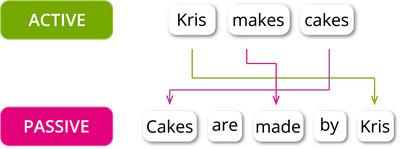Learn: every day, we hear the news: "A bank was robbed." "A suspect was arrested." "The road was closed after an accident." Have you noticed that sometimes we talk about what happened, not who did it? In this unit, you’ll explore how English helps us focus on actions, results, and events — a skill that’s especially useful when talking about safety, crimes, and reports. Watch the video:
Key Takeaways:
1. The Essence
2. The Usage
The passive voice is used when the action is more important than the person who does it. It shows that something happened, but it doesn't always say who did it.
"The bank was robbed." — This example illustrates the essence of the Passive Voice. There is no mention of who did the action, meaning, we do not know who robbed the bank.
"The bank was robbed." — This example illustrates the essence of the Passive Voice. There is no mention of who did the action, meaning, we do not know who robbed the bank.
When we don’t know who did the action.
"The bank was robbed last night."
When we don’t want to say who did it.
"A mistake was made."
When the thing that receives the action is more important.
"Thanksgiving is celebrated in the U.S. and Canada."
When we describe factual or formal information, such as news or reports.
"Wine is produced in France."
"The bank was robbed last night."
When we don’t want to say who did it.
"A mistake was made."
When the thing that receives the action is more important.
"Thanksgiving is celebrated in the U.S. and Canada."
When we describe factual or formal information, such as news or reports.
"Wine is produced in France."
3. Formation

The basic structure: be + past participle (V3)
The verb "be" changes according to the tense.
The main verb is always in past participle form.
The verb "be" changes according to the tense.
The main verb is always in past participle form.
Study the formation of the Passive Voice from these examples:

Besides the basic structure, you need to remember the formation for continuous and perfect tenses:
Continuous Tenses: be + being + past participle
Active voice: John is making tea. (Present Continuous)
Passive voice: Tea is being made by John.
Perfect Tenses: have / had + been + past participle
Active voice: John has made tea. (Present Perfect)
Passive voice: Tea has been made by John.
Optional “by…” phrase
You can include the “doer” of the action using by + person, but it’s not always needed.
The brownies were eaten (by her friends).
The driver was fined (by the police).
If the person is unknown or unimportant, we usually leave it out.
You can include the “doer” of the action using by + person, but it’s not always needed.
The brownies were eaten (by her friends).
The driver was fined (by the police).
If the person is unknown or unimportant, we usually leave it out.
Remember!

2. Add "by + doer" only if it adds important information.
3. The tense in the passive is the same as in the active sentence.
Svarīgi!
1. Focus on the object from the active sentence becomes the subject in the passive one. Study this example:

2. Add "by + doer" only if it adds important information.
3. The tense in the passive is the same as in the active sentence.
Atsauce:
lingoni ENGLISH “Passive voice – B2” on youtube.com